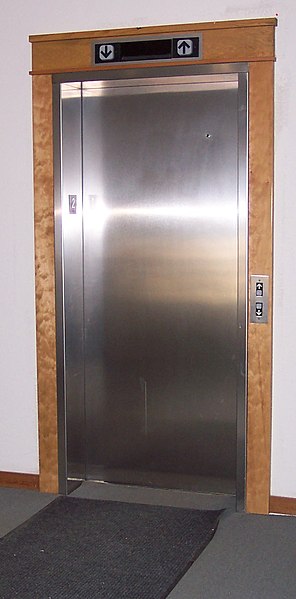Don't make elevators into Jerks!

I just stumbled onto a blog written by a fellow named David Louis Edelman by way of a three-part article that caught my eye called ‘Building the Perfect Interface’. From Edelman:
"Take the standard elevator. Elevators are extremely dumb machines. They spend large amounts of time sitting on the wrong floor. When you walk up to the elevator, the only interface you’ve got is a simple two-button panel that asks whether you’re going up or down. People often end up piling into multiple elevators that are going to the same destinations, requiring all of the elevators to stop at multiple floors. The buttons for opening and closing the doors once you’re in there are a bad joke — by the time you find them, it’s either too late to stop the doors or just an unnecessary extra redundancy.David Louis Edelman brings up some very good points and some very bad ones here in the same breath. I think it’s helpful for us interface designers to recognize the well-supported insights offered by enthusiasts (Edelman himself is a programmer and a novelist- not a user interface designer), while at the same time being able to quickly point out areas of caution.How come the elevators don’t know where you’re going already? If you’re in a strange building, that’s understandable — but why should you have to push the same button for your apartment or office every day? Couldn’t the building automatically sense that someone’s waiting for the elevator via motion detectors? And couldn’t it automatically sense which floor you’re heading to by reading an RFID chip in your key? Hell, the elevator should start making decisions about which elevator to send and when as soon as I enter the parking garage."
Elevators are indeed extremely dumb machines. They are like traffic lights in that they don’t make use of much intelligence, and people generally accept the way they are because they use them so often and really only pay any attention to them when they behave particularly poorly.
However, the author treads into dangerous territory when he suggests that elevators should not force us to make decisions and tell it where to go every day- that the elevator should be the one that makes the decisions. After all, the technology is available for the elevators to be smart enough to do this for us, right?
Right…if you’re one of those kinds of people whom enjoy being predictable and having no say in where your body is moved about through this physical world of ours.
The truth is, people like not having to worry about the small stuff. But in order for the small stuff to be completely accounted for by technology, it needs to be done very well- and account for exceptions. The elevator that ‘knows’ where you want to go and takes you there automatically is very presumptuous- almost a bit rude. Although it might seem great at first that you are forever free from pressing that damn button every damn day (which can be disburdened many other ways), you will quickly change your mind about it the one time you carelessly decide to leave your apartment to head up to you’re friend’s place on the 14th floor and the elevator smugly guides you to your car in the basement. Was it your fault you didn’t let the elevator know ahead of time to divert from the usual path? Now we’ve introduced another set of stuff you have to worry about…Wasn’t the point to rid yourself of effort and thought?!
I think at this point in time, we really need to concern ourselves with aiding people’s decision making skills, and not making decisions for them. And when I say decisions, I mean larger and personal ones like where to go, and not teensy or impersonal ones like organizing your online movie library into genre taxonomies. After all, people like to make decisions about things that are important to them. Control is desirable.
The elevator should be smart enough to know all sorts of information about our usage patterns, where we live or work in the building (as long as we want it to know that!), and what floors we are probably going to be visiting given the day and time…However, this information needs to be used to do things like prepare and suggest- not to assume and decide. That’s our job! It reminds me of some of the points made by Don Norman in his latest book, “The Design of Future Things”. To be honest, I wasn’t a big fan of the book in light of his other big sellers, but it did offer sound advice on people trying to design the next wave of intelligent products and services.
All in all, Edelman did have some good ideas. I do think it would be handy for an elevator to be present (or quickly on its way) depending on when you’ve arrived and gotten out of your car. But I think things like emphasizing floors by remembering the person’s previous decisions and/or their RFID info might be more helpful rather than kidnapping them and taking them there without asking first. These, in addition to improving the interface by way of adhering to proper design principles of proximity and cognitive load, would be a huge improvement. Of course some caveats that would still need to be worked out though:
- How do we make decisions about what we want the elevator to know about us?
- How do we handle multiple people in one elevator with conflicting goals, locations, and privacy preferences?
- How do we design these so-called intelligent elevators differently depending on whether the users are frequent or infrequent (e.g. office buildings vs. hotels)?
